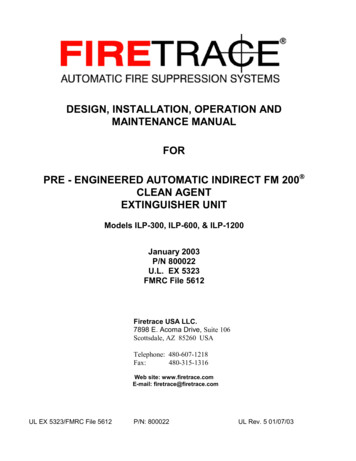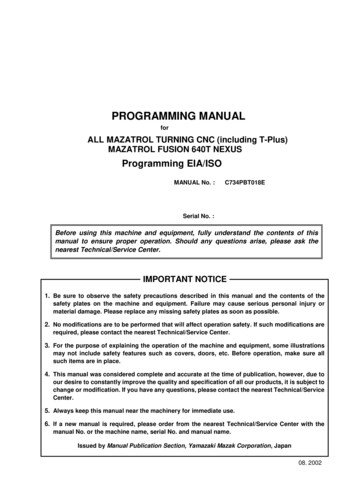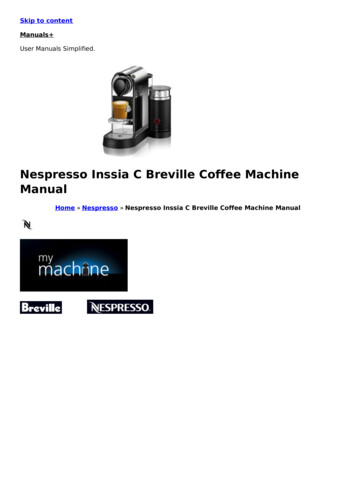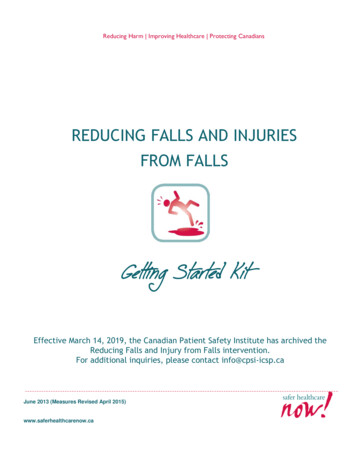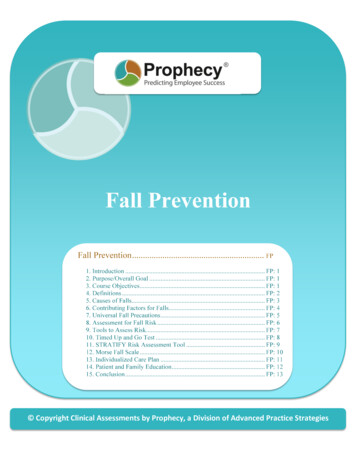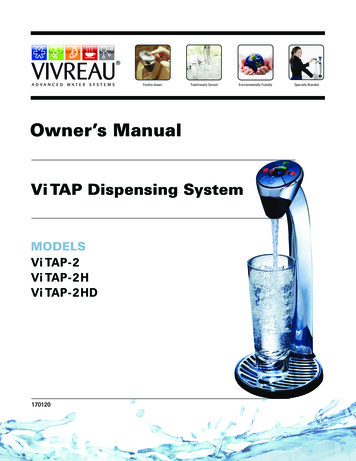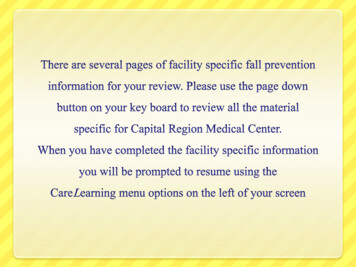
Transcription
Standard Precautions:A Focus on Hand HygieneFACILITATOR GUIDEDeveloped by:UW OshkoshCenter for Community Development, Engagement and Training (CCDET)Permission is granted to reproduce these training materials with proper attribution for internal use withinhealthcare organizations or government agencies at no cost to the training participants. Otherreproduction is prohibited without written permission from UW Oshkosh CCDET. All rights are reserved.For information on reproducing these materials, please contact UW Oshkosh CCDET atcaregiver@uwosh.eduwww.uwosh.edu/ccdet/caregiver
Standard Precautions: Hand HygieneFacilitator GuideTable of ContentsLearning Points . 3What are Standard Precautions? . 3Communicable Diseases . 4Norovirus . 5MRSA (Methicillin-resistant Staphylococcus aureus) . 7Flu (Influenza) . 8Other Communicable Diseases . 9Hand Hygiene Plays a Strong Role . 10Activity: Practice Hand Hygiene Techniques . 12Personal Protective Equipment . 14Activity: Removing Gloves . 16Wrap-Up . 17Facilitator Preparation . 18Resources . 19NOTE: This is NOT the department-approved training on Standard Precautionsrequired under DHS 83.20 for CBRFs.UW Oshkosh CCDETFebruary 20162
Standard Precautions: Hand HygieneFacilitator GuideLearning PointsThese are the major goals for this training: Review standard precautions and why they are important in your workLearn more about common communicable diseases in healthcare facilitiesPractice/review hand hygiene techniquesWhat are Standard Precautions?Standard precautions are ways of doing your work to lower thechance of spreading disease. They consist of hand hygiene,protective equipment, care of the environment and safe injectionpractices. They are based on the principle that all blood, bodyfluids, secretions, excretions except sweat, non-intact skin andmucous membranes may be capable of transmitting infection.You must follow standard precautions whenever you care for a resident, even if theperson doesn’t seem to have an infection or a disease that can spread to anotherperson. Standard precautions can prevent you from becoming infected. They can alsoprotect residents by ensuring that you don’t carry infectious agents on your hands,clothing or equipment.[If your audience is from a facility that is required to have written policies re: standardprecautions or infection control, bring a copy of the document to the training. (E.g.CBRFs are required to have written infection control programs.) Review it briefly, ask ifparticipants understand its purpose, know where to access it, etc. Focus specifically onany written hand hygiene policy.]UW Oshkosh CCDETFebruary 20163
Standard Precautions: Hand HygieneFacilitator GuideAlthough standard precautions include several topics, this training focuses on handhygiene and its role in preventing the spread of communicable disease.It is estimated that failure to practice proper hand hygiene is the #1 cause of the spreadof disease in healthcare facilities.Communicable DiseasesSome communicable diseases are bloodborne and others spread through contactbetween people. Can you think of some examples of common communicablediseases?[Ask participants to name some examples. List them on a flip chart. Examples mayinclude colds, the flu, measles, athlete’s foot, whooping cough, ringworm, HIV, HepatitisB, Hepatitis C, etc.]Most healthcare workers must be screened for clinically apparent communicablediseases, including tuberculosis. The purpose of this is to prevent the spread ofcommunicable disease to residents and other staff.Employees who exhibit signs and symptoms of a communicable disease may not bepermitted to work. Employees should seek the advice of a medical professional.New residents must have a health exam to check for health problems and screen forclinically apparent communicable diseases, including tuberculosis. This helps to makesure that residents get proper treatment so that illnesses are not passed on to otherresidents or staff.Let’s focus on three of the more common communicable diseases that occur in longterm care settings.UW Oshkosh CCDETFebruary 20164
Standard Precautions: Hand HygieneFacilitator GuideNorovirusIn recent years, almost two-thirds of the confirmed outbreaks ofnorovirus in the U.S. occurred in long-term care facilities.You may hear norovirus illness called "food poisoning" or"stomach flu." Food poisoning can be caused by noroviruses,but other germs and chemicals can also cause food poisoning.Norovirus illness is not related to the flu (influenza), which is arespiratory illness caused by influenza virus.The norovirus can cause severe and sudden gastroenteritis (i.e., inflammation of thelining of the stomach and intestines). Both healthy and compromised persons can beaffected. Symptoms include nausea, vomiting, diarrhea, and some stomach cramping.The virus is very contagious and easily transmitted through contaminated hands,equipment/surfaces, or food/water.The virus can be introduced into healthcare facilities by residents—who may or may notbe showing symptoms—or by staff, visitors, or contaminated foods. Outbreaks in thesesettings can be quite long, sometimes lasting months. Illness can be more severe,occasionally even fatal, in hospitalized patients or long-term care residents comparedwith otherwise healthy people.Standard Precautions Help Control the Spread ofNorovirusPractice proper hand hygieneWash your hands carefully with soap and water, especially afterusing the toilet, toileting residents, changing incontinence products,and always before eating or preparing food. If soap and wateraren't available, use an alcohol-based hand sanitizer. Thesealcohol-based products can quickly reduce the number of germs onhands in some situations, but they are not a substitute for washingwith soap and water to kill norovirus.Alcohol-based hand sanitizers can be used in addition to hand washing. However,they should not be used as a substitute for washing with soap and water in the case ofnorovirus outbreak.UW Oshkosh CCDETFebruary 20165
Standard Precautions: Hand HygieneFacilitator GuideTake care in the kitchenCarefully wash fruits and vegetables, and cook oysters and other shellfish thoroughlybefore eating them.Do not prepare food while infectedPeople with norovirus illness should not prepare food for others while they havesymptoms and for 3 days after they recover from their illness.Clean and disinfect contaminated surfacesAfter throwing up or having diarrhea, immediately clean and disinfect contaminatedsurfaces by using a bleach-based household cleaner as directed on the product label. Ifno such cleaning product is available, you can use a solution made with 5 tablespoonsto 1.5 cups of household bleach per 1 gallon of water.Wash laundry thoroughlyImmediately remove and wash clothing or linens that may be contaminated with vomitor stool. Handle soiled items carefully—without agitating them—to avoid spreadingvirus. If available, wear rubber or disposable gloves while handling soiled clothing orlinens and wash your hands after handling. The items should be washed with detergentat the maximum available cycle length and then machine dried.UW Oshkosh CCDETFebruary 20166
Standard Precautions: Hand HygieneFacilitator GuideMRSA (Methicillin-resistant Staphylococcusaureus)MRSA is a type of staphylococcus bacteria. “Staph” is a verycommon germ that about one out of every three people has ontheir skin or in their nose. This germ does not cause anyproblems for most people who have it on their skin. Sometimesit can cause serious infections such as skin or wound infections,pneumonia, or infections of the blood.MRSA is resistant to certain antibiotics such as those including methicillin and othermore common antibiotics such as oxacillin, penicillin, and amoxicillin. However, thereare antibiotics that can kill MRSA bacteria.In the community, most MRSA infections are skin infections that may appear as a bumpor infected area on the skin that may be: Red Swollen Painful Warm to the touch Full of pus or other drainage Accompanied by a feverMore severe or potentially life-threatening MRSA infections occur most frequentlyamong residents in healthcare settings. Common infections include: Surgical wound infections Urinary tract infections Bloodstream infections PneumoniaUW Oshkosh CCDETFebruary 20167
Standard Precautions: Hand HygieneFacilitator GuideStandard Precautions Help Control the Spread of MRSAThe #1 precaution that caregivers can take against the spread of MRSA is performinghand hygiene. Perform hand hygiene after touching blood, body fluids, secretions, excretions,and contaminated items, whether or not gloves are wornPerform hand hygiene immediately after gloves are removed, between patientcontacts, and when otherwise indicated to avoid transfer of microorganisms toother patients or environmentsWhen hands are visibly soiled with blood or other body fluids, wash hands withsoap and waterIt may be necessary to perform hand hygiene between tasks and procedures onthe same patient to prevent cross-contamination of different body sitesSeveral other standard precautions or contact precautions may also help prevent thespread of MRSA and may be required by your employer.Flu (Influenza)Although there are several types of influenza, perhaps the mostcommon is the seasonal flu. In the U.S., winter is the time forflu, but the exact timing and duration of flu seasons vary. The fluis a contagious respiratory illness caused by influenza virusesthat infect the nose, throat, and lungs. It can cause mild tosevere illness, and at times can lead to death. The best way toprevent the flu is by getting a flu vaccine each year.People who have the flu often feel some or all of these signs and symptoms: Fever* or feeling feverish/chills Cough Sore throat Runny or stuffy nose Muscle or body aches Headaches Fatigue (very tired) Some people may have vomiting and diarrhea, though this is more common inchildren than adults.*It’s important to note that not everyone with flu will have a fever.People over 65 and those with medical conditions may suffer complications from the flu.Complications of flu can include bacterial pneumonia, ear infections, sinus infections,UW Oshkosh CCDETFebruary 20168
Standard Precautions: Hand HygieneFacilitator Guidedehydration, and worsening of chronic medical conditions, such as congestive heartfailure, asthma, or diabetes.Most experts believe that flu viruses spread mainly by droplets made when people withflu cough, sneeze or talk. These droplets can land in the mouths or noses of peoplewho are nearby. Less often, people might also get flu by touching a surface or objectthat has flu virus on it and then touching their own mouth, eyes or possibly their nose.Standard Precautions Help Control the Spread of FluThe single best way to prevent flu is to get a flu vaccine.However, once flu has spread in a facility, caregivers mustfocus on maintaining standard precautions including: Perform hand hygiene before and after touching the resident, after touching theresident’s environment, or after touching the resident’s respiratory secretions,whether or not gloves are worn. Gloves do not replace the need for performinghand hygiene.Wear gloves if hand contact with respiratory secretions or potentiallycontaminated surfaces is anticipatedWear a gown if soiling of clothes with a resident’s respiratory secretions isanticipatedChange gloves and gowns after each resident encounter and performing handhygieneYour employer may also institute other precautions to help control the spread of flu inyour facility.Other Communicable DiseasesEscherichia Coli (E. coli)Escherichia coli bacteria normally live in the intestines of people and animals. Most E.coli are harmless and actually are an important part of a healthy human intestinal tract.However, some E. coli are pathogenic, meaning they can cause illness, either diarrheaor illness outside of the intestinal tract. The types of E. coli that can cause diarrhea canbe transmitted through contaminated water or food, or through contact with animals orpersons.UW Oshkosh CCDETFebruary 20169
Standard Precautions: Hand HygieneFacilitator GuideClostridium Difficile (C. diff)Clostridium difficile is a toxin-producing bacillus that causes diarrhea. Any surface,device, or material (e.g., toilets, bathing tubs, and electronic rectal thermometers) thatbecomes contaminated with feces may serve as a reservoir for the spores. C. diffspores are transferred to patients mainly via the hands of healthcare personnel whohave touched a contaminated surface or item.Hand sanitizer does not kill C. diff. Hand hygiene with soap and water is recommendedin outbreak settings.Hand Hygiene Plays a Strong RoleAs we can see from our review of common contagious diseases,hand hygiene is an important factor in preventing the spread ofinfection. Keeping your body clean, including your hands, helpskeep diseases from spreading from person to person. Hand hygieneincludes both washing with soap and water or using alcohol gel.Always use soap and water if your hands are visibly dirty, beforepreparing food and after using the restroom.Although many of us learned about hand hygiene in the past, it continues to be thecause of many deficiencies cited in healthcare facilities. In other words, caregivers areeither failing to practice hand hygiene properly or skipping it all together in somecircumstances.Let’s spend some time refreshing our knowledge of the principles of proper handhygiene. These are the recommendations of the U.S. Centers for Disease Control andPrevention (CDC):UW Oshkosh CCDETFebruary 201610
Standard Precautions: Hand HygieneFacilitator GuideWhen Must I Perform Hand Hygiene?[Using a flip chart or white board, write the words Before and After. Give participants amoment or two to write responses in their guides. Ask for voluntary responses andrecord them on the flipchart. Include responses listed below if participants don’t mentionthem.]Before:[Having contact with residents, putting on gloves, caring for any invasive device (such asa catheter), handling food, administering medication. Include additional circumstancesas needed.]Right after:[Having contact with a resident’s skin; having contact with body fluids (even whengloves are worn); having contact with resident items such as dressings, dirty laundry,dishes or trash; taking off gloves; moving from parts of the resident’s body that could becontaminated to clean parts of the resident’s body, using the restroom, coughing orsneezing, smoking. Include additional circumstances as needed.]UW Oshkosh CCDETFebruary 201611
Standard Precautions: Hand HygieneFacilitator GuideActivity: Practice Hand Hygiene TechniquesHandwashing is like a "do-it-yourself" vaccine—it involves five simple and effectivesteps (Wet, Lather, Scrub, Rinse, Dry) you can take to reduce the spread of diarrhealand respiratory illness so you can stay healthy. Regular handwashing, particularlybefore and after certain activities, is one of the best ways to remove germs, avoidgetting sick, and prevent the spread of germs to others. It's quick, it's simple, and it cankeep us all from getting sick. Handwashing is a win for everyone, except the germs.http://www.cdc.gov/cdctv/handstogether/[The link above is embedded in the PPT that accompanies this training. You can play itdirectly from the internet or save it to your own computer.]Hand Hygiene StepsWashing hands with soap and water is the best way to reduce the number of germs onthem in most situations. If soap and water are not available, use an alcohol-based handsanitizer that contains at least 60% alcohol. Alcohol-based hand sanitizers can quicklyreduce the number of germs on hands in some situations, but sanitizers do noteliminate all types of germs and might not remove harmful chemicals.Hand sanitizers are not as effective when hands are visibly dirty or greasy. Hand Washing (soap and water)Wet your hands with clean, running water (warm or cold), turn off the tap, andapply soap. Lather your hands by rubbing them together with the soap. Be sure to lather thebacks of your hands, between your fingers, and under your nails. Scrub your hands for at least 20 seconds. Need a timer? Hum the "HappyBirthday" song from beginning to end twice. Rinse your hands well under clean, running water. Dry your hands using a clean towel or air-dry them.[It is strongly suggested that, in this activity, participants have an opportunity to practiceboth techniques, even those with long experience. NOTE: While some people learn skillswell from lecture or watching a demonstration, most learn best by practice andrepetition.]UW Oshkosh CCDETFebruary 201612
Standard Precautions: Hand HygieneFacilitator GuideWhat should you use if you don’t have soap and clean, running water? Hand Sanitizer (foam or gel)Apply the product to the palm of one hand (read the label to learn the correctamount). Rub your hands together. Rub the product over all surfaces of your hands and fingers until your hands aredry.Soap vs. Hand SanitizerAlcohol-based hand sanitizers can quickly reduce the number of microbes on hands insome situations, but sanitizers do not eliminate all types of germs. Why? People maynot use a large enough volume of the sanitizer or may wipe it off before it has dried.Furthermore, soap and water are more effective at removing or inactivating certainkinds of germs, like cryptosporidium, norovirus, and c. diff.Alcohol-based hand rubs are less drying to hands than using soap and water. Handrubs can be placed in locations where sinks aren’t available so they are moreconvenient to use.Use of Hand LotionsCaregivers may experience dryness from frequent hand cleansing. Lotions areimportant to prevent dryness and irritation.You should only use hand lotions approved by your employer. Other lotions can: Make hand hygiene less effectiveCause a breakdown of disposable glovesBecome contaminated with bacteria if dispensers are refilledFingernailsYour employer may have a policy regarding fingernails. If not, it’s best to keep yourfingernails natural and cut to about ¼ inch. Artificial or long nails harbor bacteria, takelonger to clean and can puncture disposable gloves.[Optional activity: Consider playing the following ractiveEducation/. You can haveparticipants answer questions aloud. There is another demonstration of hand washingand hand rubbing toward the end of the video.]UW Oshkosh CCDETFebruary 201613
Standard Precautions: Hand HygieneFacilitator GuidePersonal Protective EquipmentPersonal protective equipment is specialized clothing or equipment.Wear it to protect your skin and to prevent soiling or contamination ofyour clothing from contact with bloodborne pathogens. You must wear gloves whenever there is a chance that your hands could havecontact with blood or other body fluidsYou must wear a gown whenever there is a chance that other parts of yourbody may be exposed to blood or other body fluidsYou must wear a mask or eye protection whenever there is a chance that youreyes, nose or mouth could come in contact with blood or other body fluidsYour CBRF must provide personal protective equipment at no cost to you. It must beavailable to you whenever you need it.If you believe you need personal protective equipment to complete a task safely and theequipment is not available, do not proceed with the task. Report the lack of equipmentto your supervisor.When you remove personal protective equipment, put it in an appropriately designatedarea or container for storage, washing or disposal.GlovesGloves are a very important part of keeping both you and residents safe fromcommunicable diseases. Gloves can only do their job if you put them on before you areexposed to blood or body fluids. Most facilities use disposable gloves. Hypoallergenic(not likely to cause allergic reaction) gloves must be available. Latex gloves are anexample of gloves that may cause allergic reactions in some people.UW Oshkosh CCDETFebruary 201614
Standard Precautions: Hand HygieneFacilitator GuideRules for Wearing GlovesWear clean gloves when: Touching blood or any other body fluidCaring for any invasive device, such as a catheterHaving contact with items that could contain body fluids such as dressings, dirtylaundry, dishes or trashMoving from parts of the resident’s body that could be contaminated to cleanparts of the resident’s bodyYour facility’s policy requires the use of glovesAlways follow these rules: Carefully remove used gloves so that the outer surface never touches your skinWear gloves that fit – gloves that are too small or too big can tearWash your hands after glove removalNever wear the same gloves for the care of more than one resident!Never reuse gloves!UW Oshkosh CCDETFebruary 201615
Standard Precautions: Hand HygieneFacilitator GuideActivity: Removing GlovesWhat is the correct way to remove gloves? The CDC offers these instructions anddrawings: Grasp outside edge near wrist Peel away from hand, turning gloveinside-out Hold in opposite gloved hand Slide ungloved finger under the wrist ofthe remaining glove Peel off from inside, creating a bag forboth glovesDiscard[Provide each participant with a pair of gloves. Before training the class, review theremoval steps above. Demonstrate the proper method of glove removal and giveparticipants a chance to practice.Ask participants to locate glove and other personal protective equipment policies in theCBRF infection control program. Ask for comments on whether the policies are present,understandable and whether they are familiar with them.]UW Oshkosh CCDETFebruary 201616
Standard Precautions: Hand HygieneFacilitator GuideWrap-UpBe a role model. Show co-workers, supervisors and residents that you are seriousabout everyone’s health and safety by practicing standard precautions at all times. Agood slogan to remember is:Practice Standard Precautions. It’s Contagious!Learning Points ReviewLet’s review the learning points from today’s training: Review standard precautions and why they are important in your workLearn more about common communicable diseases in healthcare facilitiesPractice/review hand hygiene techniques[Point out how each part of the training covered the learning points. For example, welearned more about common communicable diseases. Thank participants for attending.Ask if there are any questions. If you wish, seek input on the training via (your own)training evaluations.]UW Oshkosh CCDETFebruary 201617
Standard Precautions: Hand HygieneFacilitator GuideFacilitator PreparationFor this training, facilitators will need: Hand washing sink, soap, hand rub (foam or gel), paper towels (recommended)MS PowerPoint (PPT Viewer can be downloaded for free at www.microsoft.com)LCD projector (recommended)Screen for viewing the PPT (recommended)Internet access (recommended)Flip chart/whiteboard and markersPrinted Participant Guides (one for each student recommended)Pens or pencilsEvaluation for participants (optional)Attendance certificate (recommended)Note: It is strongly recommended that the PPT be viewed using an LCD projector. Ifthat option is not available, the PPT may be downloaded and printed as a handout.UW Oshkosh CCDETFebruary 201618
Standard Precautions: Hand HygieneFacilitator GuideResourcesThe following are resources used for this curriculum. These resources may alsoprovide valuable information about current standards and practices. Instructors andstudents are encouraged to explore the resources to increase program knowledge.U.S. Centers for Disease Control and Preventionhttp://www.cdc.gov/A US government agency whose mission is to create the expertise, information, andtools that people and communities need to protect their health – through healthpromotion, prevention of disease, injury and disability, and preparedness for new SA -29-04.pdfGuidance for the Selection and Use of Personal Protective Equipment (PPE) in HealthCare Settingshttp://www.cdc.gov/cdctv/handstogether/Put Your Hands Together VideoWorld Health Organizationhttp://www.who.int/gpsc/5may/How To HandWash Poster.pdfHow to Wash Your Hands Posterhttp://www.who.int/gpsc/5may/How To HandRub Poster.pdfHow to Rub Your Hands (Clean) PosterWisconsin Administrative min code/dhsAdministrative rules governing all DHS-regulated facilitiesWisconsin State prefaces/tocA list of all statutes in Wisconsin. Chapter 50 covers Uniform Licensure of DQAregulated facilities.Wisconsin Department of Health dex.htmThe Division of Quality Assurance (DQA) Numbered Memos deal with policies,information and interpretation of federal as well as state regulations and guidelines ofthe programs under DQA's jurisdiction.UW Oshkosh CCDETFebruary 201619
UW Oshkosh CCDET 3 February 2016 Learning Points These are the major goals for this training: Review standard precautions and why they are important in your work Learn more about common communicable diseases in healthcare facilities Practice/review hand hygiene techniques What are Standard Precautions?
